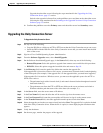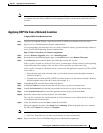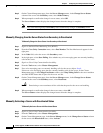
4-3
Install, Upgrade, and Maintenance Guide for Cisco Unity Connection Release 10.x
Chapter 4 Configuring Cisco Unity Connection Cluster
Administering a Unity Connection Cluster
Table 4-1 Server Assignments and Usage of Voice Messaging Ports in a Unity Connection Cluster
Integration Type Server Assignments and Usage of Voice Messaging Ports
Integration by Skinny Client Control
Protocol (SCCP) with Cisco Unified
Communications Manager or Cisco
Unified Communications Manager
Express
• The phone system is set up with twice the number of SCCP voicemail port
devices that are needed to handle the voice messaging traffic. (For example,
if 16 voicemail port devices are needed to handle all voice messaging traffic,
32 voicemail port devices must be set up on the phone system.)
• In Cisco Unity Connection Administration, the voice messaging ports are
configured so that half the number of the ports set up on the phone system
are assigned to each server in the cluster. (For example, each server in the
cluster has 16 voice messaging ports.)
• On the phone system, a line group, hunt list, and hunt group are configured
to enable the subscriber server answer most of the incoming calls for the
cluster.
• If one of the servers stops functioning (for example, when it is shut down for
maintenance), the remaining server assumes responsibility of handling all
incoming calls for the cluster.
• When the server that stopped functioning is able to resume its normal
functions and is activated, it resumes the responsibility of handling its share
of incoming calls for the cluster.
Integration through a SIP Trunk with
Cisco Unified Communications Manager
or Cisco Unified Communications
Manager Express
• In Cisco Unity Connection Administration, half the number of voice
messaging ports that are needed to handle voice messaging traffic are
assigned to each server in the cluster. (For example, if 16 voice messaging
ports are needed to handle all voice messaging traffic for the cluster, each
server in the cluster is assigned 8 voice messaging ports.)
• On the phone system, a route group, route list, and route pattern are
configured to distribute calls equally between both servers in the cluster.
• If one of the servers stops functioning (for example, when it is shut down for
maintenance), the remaining server assumes responsibility of handling all
incoming calls for the cluster.
• When the server that stopped functioning is able to resume its normal
functions and is activated, it resumes responsibility of handling its share of
incoming calls for the cluster.


















